Euphyllin for inj. 2,4% 10ml #10
- $25.70
- 3 or more $25.30
- Availability:In Stock
Euphylin instruction for useYou can buy Euphyllin herepharmachologic effectBronchodilator, inhibitor of PDE. It is the ethylenediamine salt of theophylline (which facilitates solubility and increases
Euphylin instruction for use
You can buy Euphyllin here
pharmachologic effect
Bronchodilator, inhibitor of PDE. It is the ethylenediamine salt of theophylline (which facilitates solubility and increases absorption). It has a bronchodilator effect, apparently due to a direct relaxing effect on the smooth muscles of the airways and blood vessels of the lungs. It is believed that this action is caused by selective suppression of the activity of specific PDEs, which leads to an increase in the intracellular concentration of cAMP. The results of experimental studies in vitro show that the main role is apparently played by isoenzymes of types III and IV. Suppression of the activity of these isoenzymes can also cause some side effects of aminophylline (theophylline), including. vomiting, arterial hypotension and tachycardia. It blocks adenosine (purine) receptors, which can be one of the factors of action on the bronchi.
Reduces airway hyperreactivity associated with the late phase of the reaction caused by the inhalation of allergens, through an unknown mechanism that does not relate to inhibition of PDE or to blockade of adenosine. There are reports that aminophylline increases the number and activity of T suppressors in peripheral blood.
It increases mucociliary clearance, stimulates diaphragm contraction, improves the function of respiratory and intercostal muscles, stimulates the respiratory center, increases its sensitivity to carbon dioxide and improves alveolar ventilation, which ultimately reduces the severity and frequency of episodes of apnea. Normalizing the respiratory function, contributes to the saturation of blood with oxygen and a decrease in the concentration of carbon dioxide. Strengthens lung ventilation in hypokalemia.
Has a stimulating effect on the activity of the heart, increases strength and heart rate, increases coronary blood flow and increases myocardial oxygen demand. Reduces the tone of blood vessels (mainly vessels of the brain, skin and kidneys). Has peripheral venodilating effect, reduces pulmonary vascular resistance, lowers pressure in a small circle of blood circulation. Increases renal blood flow, has a moderate diuretic effect. Expands extrahepatic biliary tract. Stabilizes the membranes of mast cells, inhibits the release of mediators of allergic reactions. It inhibits platelet aggregation (suppresses the platelet activation factor and PgE2?), increases the resistance of erythrocytes to deformation (improves the rheological properties of the blood), reduces thrombus formation and normalizes microcirculation. Has tocolytic effect, increases the acidity of gastric juice. In high doses, it has an epileptogenic effect.
Pharmacokinetics
In the body, aminophylline is metabolized at physiological pH values ??with the release of free theophylline. Bronchodilator properties appear at concentrations of theophylline in the blood plasma of 10-20 ?g / ml. Concentration above 20 mg / ml is toxic. The excitatory effect on the respiratory center is realized at a lower concentration - 5-10 ?g / ml.
The binding of theophylline to plasma proteins is approximately 40%; In newborns, as well as in adults with diseases, binding decreases. Binding to plasma proteins in adults is about 60%, in newborns - 36%, in patients with cirrhosis of the liver - 36%. Penetrates through the placental barrier (concentration in the fetal serum is slightly higher than in the mother's serum). Excreted in breast milk.
Theophylline is metabolized in the liver with the participation of several cytochrome P450 isoenzymes, the most important of which is CYP1A2. In the process of metabolism, 1,3-dimethylurea, 1-methylmercury and 3-methylxanthine are formed. These metabolites are excreted in the urine. In unchanged form, adults are 10%. In newborns, a significant proportion is excreted in the form of caffeine (due to the immaturity of the ways of its further metabolism), in unchanged form - 50%.
Significant individual differences in the rate of hepatic metabolism of theophylline are the cause of pronounced variability in the values ??of clearance, plasma concentration, half-life. The liver metabolism is influenced by factors such as age, addiction to tobacco smoking, diet, diseases, concomitant drug therapy.
T1 / 2 theophylline in non-smoking patients with bronchial asthma with practically no pathological changes from other organs and systems is 6-12 hours, smokers 4-5 hours, children 1-5 hours, newborns and premature infants - 10- 45 hours
T1 / 2 theophylline is increased in the elderly and in patients with heart failure or liver disease.
Clearance decreases with heart failure, violations of liver function, chronic alcoholism, pulmonary edema, COPD.
Ethylenediamine does not affect the pharmacokinetics of theophylline.
Indications
For parenteral use: asthmatic status (additional therapy), apnea of ??newborns, cerebrovascular insufficiency in ischemic type (as part of combination therapy), left ventricular failure with bronchospasm and Cheyne-Stokes respiratory failure, edematous renal genesis (as part of complex therapy) ; acute and chronic heart failure (as part of combination therapy).
For oral administration: bronchoobstructive syndrome of various genesis (including bronchial asthma, COPD, including pulmonary emphysema, chronic obstructive bronchitis), hypertension in a small circulatory system, pulmonary heart, nocturnal apnea; acute and chronic heart failure (as part of combination therapy).
Contraindications
Severe hypertension or hypotension, tachyarrhythmias, peptic ulcer disease in the exacerbation phase, hyperacid gastritis, severe liver and / or kidney dysfunction, epilepsy, hemorrhagic stroke, retinal hemorrhage, simultaneous use with ephedrine in children, childhood (up to 3 years, for prolonged oral forms - up to 12 years), hypersensitivity to aminophylline and theophylline.
Dosage
Individual, depending on the indications, age, clinical situation, route and schedule of administration, nicotine addiction.
Side effects
From the nervous system: dizziness, sleep disturbances, anxiety, tremors, convulsions.
From the cardiovascular system: a feeling of heartbeat, heart rhythm disturbances; with rapid on / in the introduction - the appearance of pain in the heart, lowering blood pressure, tachycardia (including the fetus during admission in the III trimester of pregnancy), arrhythmias, lowering blood pressure, cardialgia, an increase in the frequency of attacks of angina.
From the digestive system: nausea, vomiting, gastroesophageal reflux, heartburn, peptic ulcer, diarrhea; with prolonged ingestion - anorexia.
From the urinary system: albuminuria, hematuria.
Allergic reactions: skin rash, itching, fever.
From the side of metabolism: rarely - hypoglycemia.
Local reactions: compaction, hyperemia, tenderness at the injection site; rectal administration irritation of the rectal mucosa, proctitis.
Other: chest pain, tachypnea, sensation of hot flashes to the face, albuminuria, hematuria, hypoglycemia, increased diuresis, increased sweating.
Drug Interactions
When used simultaneously with sympathomimetics, the effect is mutually reinforced; with beta-adrenoblockers and lithium preparations - the effect is mutually reduced. The intensity of the action of aminophylline may decrease (due to an increase in its clearance) with simultaneous use with phenobarbital, rifampicin, isoniazid, carbamazepine, sulfinpyrazone, phenytoin, and also in smokers.
The intensity of the action of aminophylline may increase (due to a decrease in its clearance) with simultaneous use with antibiotics from the group of macrolides, lincomycin, with quinolones, allopurinol, beta-adrenoblockers, cimetidine, disulfiram, fluvoxamine, hormonal contraceptives for ingestion, isoprenaline, viloxazine and in vaccination against influenza.
Xanthine derivatives can potentiate hypokalemia due to the action of ?2-adrenoreceptor stimulants, corticosteroids and diuretics.
Antidiarrhoeal drugs and enterosorbents reduce the absorption of aminophylline.
Pharmaceutically incompatible with acid solutions.
special instructions
C with caution in severe coronary insufficiency (acute phase of myocardial infarction, angina pectoris), advanced atherosclerosis, hypertrophic obstructive cardiomyopathy, frequent ventricular extrasystole, increased convulsive readiness, with hepatic and / or renal insufficiency, gastric ulcer and duodenal ulcer (in anamnesis), with recent bleeding from the gastrointestinal tract, uncontrolled hypothyroidism (the possibility of cumulation) or thyrotoxicosis, with prolonged hyperthermia, gastroesophageal reflux, prostatic hypertrophy, in patients in the elderly, in children (especially inside).
Correction of the dosage regimen of aminophylline may be required for heart failure, violations of liver function, chronic alcoholism, fever, acute respiratory disease.
Older patients may need a dose reduction.
When you replace the drug form of aminophylline with another, you need to monitor and monitor the concentration of theophylline in the blood plasma.
Aminophylline is not used simultaneously with other xanthine derivatives. During the period of treatment, avoid eating foods containing xanthine derivatives (strong coffee, tea).
With caution apply simultaneously with anticoagulants, with other derivatives of theophylline or purine.
You should avoid simultaneous use with beta-blockers.
Aminophylline should not be used simultaneously with a solution of glucose.
Do not use rectally in children.
Pregnancy and lactemia
Theophylline penetrates the placental barrier. The use of aminophylline during pregnancy can lead to the creation of potentially dangerous concentrations of theophylline and caffeine in the blood plasma of the newborn. Newborns whose mothers received aminophylline during pregnancy (especially in the third trimester) require medical supervision to monitor possible symptoms of theophylline intoxication.
Theophylline excreted in breast milk. When using aminophylline in a lactating mother during lactation, irritability may develop in the child.
Thus, the use of aminophylline during pregnancy and lactation (breastfeeding) is possible in cases where the intended benefit of therapy for the mother exceeds the potential risk to the fetus or child.
Application in childhood
Contraindication: children's age (up to 3 years, for prolonged oral forms - up to 12 years). Do not use rectally in children.
In case of violations of kidney function
Contraindicated in severe renal dysfunction.
Use with caution in renal failure.
With violations of liver function
Contraindicated in severe violations of liver function.
Use with caution in liver failure.
Application in old age
With caution: elderly patients (dose reduction may be required).



